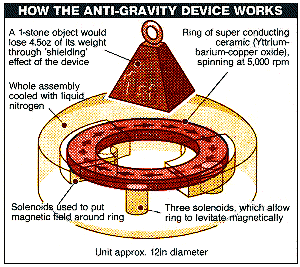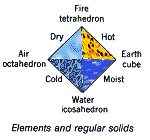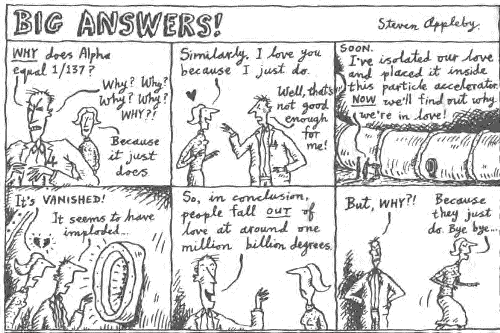 |
Breakthrough as scientists beat gravity
|
 |
by ROBERT MATTHEWS and IAN SAMPLE
SCIENTISTS in Finland are about to reveal details of the world's
first anti-gravity device.
Measuring about 12in across, the device is said to reduce significantly the
weight of anything suspended over it.
The claim - which
has been rigorously examined by scientists, and is due to appear in a physics
journal next month - could spark a technological revolution. By combating
gravity, the most ubiquitous force in the universe, everything from transport
to power generation could be transformed.
The Sunday Telegraph has learned that Nasa, the American space agency,
is taking the claims seriously, and is funding research into how
the
anti-gravity effect could be turned into a means of flight.
The researchers at the Tampere University of Technology in Finland, who
discovered the effect, say it could form the heart of a new power source,
in which it is used to drive fluids past electricity-generating turbines.
Other uses seem limited only by the imagination:
- Lifts in buildings could be replaced by devices built into the ground. People wanting to go up would simply activate the anti-gravity device - making themselves weightless - and with a gentle push ascend to the floor they want.
- Space-travel would become routine, as all the expense and danger of rocket technology is geared towards combating the Earth's gravitation pull.
-
By using the devices to raise fluids against gravity, and then
conventional gravity to push them back to earth against electricity-generating
turbines, the devices could also revolutionise power generation.
According to Dr
Eugene
Podkletnov, who led the research, the discovery was accidental. It emerged
during routine work on so-called "superconductivity", the ability
of some materials to lose their electrical resistance at very low
temperatures.
The team was carrying out tests on a rapidly spinning disc of superconducting
ceramic suspended in the magnetic field of three electric coils, all enclosed
in a low-temperature vessel called a cryostat.
"One of my friends came in and he was smoking his pipe,"
Dr Podkletnov said."He
put some smoke over the cryostat and we saw that the smoke was going to the
celing all the time. It was amazing - we couldn't explain it."
Tests showed a small drop in the weight of objects placed over the device,
as if it were shielding the object from the effects of gravity - an effect
deemed impossible by most scientists.
"We thought it might be a mistake," Dr Podkletnov said; "but we have taken
every precaution." Yet the bizarre effects persisted. The team found that
even the air pressure vertically above the device dropped slightly, with
the effect detectable directly above the device on every floor of the laboratory.
In. recent years, many so-called "anti-gravity" devices have been put forward
by both amateur and professional scientists, and all have been scorned by
the establishment. What makes this latest claim different is that it has
survived intense scrutiny by sceptical, independent experts, and has been
the Journal of Physics-D: Applied Physics, published by Britain's
Institute of Physics.
Even so, most scientists will not feel comfortable with the idea of anti-gravity
until other teams repeat the experiments.
Some scientists suspect the anti-gravity effect is a long-sought side-effect
of Einstein's general
theory of relativity, by which spinning objects can distort gravity.
Until now it was thought the effect would be far too small to measure in
the laboratory.
However, Dr Ning Li, a senior research scientist at the University of Alabama,
said that the atoms inside superconductors may magnify the effect enormously.
Her research is funded by Nasa's Marshall Space Flight Centre at Huntsville,
Alabama, and Whitt Brantley, the chief of Advanced Concepts Office there,
said: "We're taking a look at it, because if we don't, we'll never know."
The Finnish team is already expanding its programme, to see if it can amplify
the anti-gravity effect. In its latest experiments, the team has measured
a two per cent drop in the weight of objects suspended over the device -
and double that if one device is suspended over another. If the team can
increase the effect substantially, the commercial implications are enormous.
Putting spin on it
I believe that any gravitational effect of Evgeny Podkletnov's spinning
superconducting disc will be swamped by another effect (12 January, p 24).
Einstein's special theory of relativity predicts that the disc will produce
an "electrostatic" force on any nearby static charges. The effect is directly
proportional to how fast the disc is spinning, the current in the loop, and
the square of the disc's diameter.
I calculate that the 145-millimetre disc, spinning at 5000 revolutions per
minute and carrying 1000 amps, will act like a static charge of 4.3
millicoulombs, equivalent to a 20-centimetre sphere carrying 380 kilovolts.
That could exert a significant force on any test mass or balance carrying
a stray static charge, and ions present in cold dry air would drive the reported
air currents. Normal electrostatic shielding will not work as expected.
Even if this is the only effect that Podkletnov has seen, it is still valuable
new science-it would verify a core element of special relativity, and could
perhaps be scaled up and exploited to create an ion drive.
Jock Hall Ben fleet, Essex
Did anyone report a small tornado appearing above Podkletnov's laboratory?
I would have expected that, with the column of air above the antigravity
wheel being 2 per cent lighter than the surrounding air, it would have started
to rise, been replaced by heavier air, which would have also started
to rise, resulting in a minor tornado or at least a dust devil without
the benefit of dust. No?
On the other hand, I wonder why the device wasn't peddled as a perpetual
motion machine. Simply place a heavy wheel with its axis horizontal and part
of its rim above the device. That part of the rim would get lighter and the
wheel would start to rotate. Perpetual motion! Perhaps even NASA would have
bridled at spending $600,000 of the taxpayer's money for a perpetual motion
machine. Antigravity sounds more scientific, perhaps.
Paul White Portsmouth, Rhode Island
The anti-gravity machine described in Podkletnov's 1992 paper seems to be
almost identical to the gravity generators used on the starship Enterprise,
as described on page 144 of Star Trek: The Next Generation Technical Manual,
by Rick Steinbach and Michael Okuda, copyright Paramount Pictures 1991-except
that the Star Trek devices have larger superconducting discs and spin a lot
faster. Of course, that can only be a coincidence, can't it?
Howard Medhurst Crawley, West Sussex
[New Scientist 9 Feb 2002]
 PLATONIC
SOLIDS The six mathematicians were not scattered throughout the Greek
world, as had been those in the fifth century B.C.; they were associated
more or less closely with the Academy of Plato
at Athens. Although Plato himself made no outstanding
specific contribution to technical mathematical results, he was the center
of the mathematical activity of the time and guided and inspired its development.
Over the doors of his school was inscribed the motto, "Let no one ignorant
of geometry enter here"; his enthusiasm for the subject led him to become
known not as a mathematician, but as "the maker of mathematicians." It is
clear that Plato's high regard for mathematics did not come from Socrates;
in fact, the earlier Platonic dialogues seldom refer to mathematics. The
one who converted Plato to a mathematical outlook undoubtedly was Archytas,
a friend whom he visited in Sicily in 388 B.C. Perhaps it was there that
he learned of the five regular solids, which were associated with the four
Elements of Empedocles in a cosmic scheme that fascinated men for
centuries. Possibly it was the Pythagorean regard for the dodecahedron that
led Plato to look on this, the fifth and last, regular solid as a symbol
of the universe. Plato put his ideas on the regular solids into a dialogue
entitled the Timaeus, presumably named for a Pythagorean who serves as the
chief interlocutor. It is not known whether Timaeus of Locri really existed
or whether Plato invented him as a character through whom to express the
Pythagorean views that still were strong in what is now Southern Italy. The
regular polyhedra have often been called "cosmic bodies" or 'Platonic solids"
because of the way in which Plato in the Timaeus applied them to the explanation
of scientific phenomena. Although this dialogue, probably written when Plato
wia near seventy, provides the earliest definite evidence for the association
of the four Elements with the regular solids, much of this fantasy
may be due to the Pythagoreans. Proclus attributes the construction of the
cosmic figures to Pythagoras; but the scholiast Suidas reported that Plato's
friend Theaetetus, born about 414 B.C. and the son of one of the richest
patricians in Attica, first wrote on them. A scholium (of uncertain date)
to Book XIII of Euclid's Elements reports that only three of the five
solids were due to the Pythagoreans, and that it was through Theaetetus that
the octahedron and icosahedron became known. It seems likely that in any
case Theaetetus made one of the most extensive studies of the five regular
solids, and to him probably is due the theorem that there are five and only
five regular polyhedra. Perhaps he is responsible also for the calculations
in the Elements of the ratios of the edges of the regular solids to
the radius of the circumscribed sphere. Theaetetus was a young Athenian who
died in 369 B.C. from a combination of wounds received in battle and of
dysentery, and the Platonic dialogue bearing his name was a commemorative
tribute by Plato to his friend. In the dialogue, purporting to take place
some thirty years earlier, Theaetetus discusses with Socrates and Theodorus
the nature of incommensurable magnitudes. It has been assumed that this
discussion took somewhat the form that we find in the opening of Book X of
the Elements. Here distinctions are made not only between commensurable
and incommensurable magnitudes, but also between those that while incommensurable
in length are, or are not, commensurable in square. Surds such as
Ö3 and Ö5
are incommensurable in length, but they are commensurable in square, for
their squares have the ratio 3 to 5. The magnitudes
Ö(1+ Ö
3) and Ö(1+
Ö 3) on the other hand, are incommensurable
both in length and in square. PLATONIC
SOLIDS The six mathematicians were not scattered throughout the Greek
world, as had been those in the fifth century B.C.; they were associated
more or less closely with the Academy of Plato
at Athens. Although Plato himself made no outstanding
specific contribution to technical mathematical results, he was the center
of the mathematical activity of the time and guided and inspired its development.
Over the doors of his school was inscribed the motto, "Let no one ignorant
of geometry enter here"; his enthusiasm for the subject led him to become
known not as a mathematician, but as "the maker of mathematicians." It is
clear that Plato's high regard for mathematics did not come from Socrates;
in fact, the earlier Platonic dialogues seldom refer to mathematics. The
one who converted Plato to a mathematical outlook undoubtedly was Archytas,
a friend whom he visited in Sicily in 388 B.C. Perhaps it was there that
he learned of the five regular solids, which were associated with the four
Elements of Empedocles in a cosmic scheme that fascinated men for
centuries. Possibly it was the Pythagorean regard for the dodecahedron that
led Plato to look on this, the fifth and last, regular solid as a symbol
of the universe. Plato put his ideas on the regular solids into a dialogue
entitled the Timaeus, presumably named for a Pythagorean who serves as the
chief interlocutor. It is not known whether Timaeus of Locri really existed
or whether Plato invented him as a character through whom to express the
Pythagorean views that still were strong in what is now Southern Italy. The
regular polyhedra have often been called "cosmic bodies" or 'Platonic solids"
because of the way in which Plato in the Timaeus applied them to the explanation
of scientific phenomena. Although this dialogue, probably written when Plato
wia near seventy, provides the earliest definite evidence for the association
of the four Elements with the regular solids, much of this fantasy
may be due to the Pythagoreans. Proclus attributes the construction of the
cosmic figures to Pythagoras; but the scholiast Suidas reported that Plato's
friend Theaetetus, born about 414 B.C. and the son of one of the richest
patricians in Attica, first wrote on them. A scholium (of uncertain date)
to Book XIII of Euclid's Elements reports that only three of the five
solids were due to the Pythagoreans, and that it was through Theaetetus that
the octahedron and icosahedron became known. It seems likely that in any
case Theaetetus made one of the most extensive studies of the five regular
solids, and to him probably is due the theorem that there are five and only
five regular polyhedra. Perhaps he is responsible also for the calculations
in the Elements of the ratios of the edges of the regular solids to
the radius of the circumscribed sphere. Theaetetus was a young Athenian who
died in 369 B.C. from a combination of wounds received in battle and of
dysentery, and the Platonic dialogue bearing his name was a commemorative
tribute by Plato to his friend. In the dialogue, purporting to take place
some thirty years earlier, Theaetetus discusses with Socrates and Theodorus
the nature of incommensurable magnitudes. It has been assumed that this
discussion took somewhat the form that we find in the opening of Book X of
the Elements. Here distinctions are made not only between commensurable
and incommensurable magnitudes, but also between those that while incommensurable
in length are, or are not, commensurable in square. Surds such as
Ö3 and Ö5
are incommensurable in length, but they are commensurable in square, for
their squares have the ratio 3 to 5. The magnitudes
Ö(1+ Ö
3) and Ö(1+
Ö 3) on the other hand, are incommensurable
both in length and in square.[Carl C Boyer "A History of Mathematics"] |
And then there were five
THE ground is shifting under our feet. Fundamental properties
of the Universe are changing, and physicists can't explain how or why. Now
researchers say an as yet undiscovered fifth force could be behind these
mysterious changes.
|
Those who interview famous people always
hope to extract some embarrassing admission from their subjects. In the current
issue of Physics World, the editor Peter Rodgers persuades
Prof Paul Davies the distinguished physicist
and science writer, to admit to the scientific equivalent of having once
belonged to a weird cult back when he was a PhD student, Prof Davies confessed,
he had had an urge to explain why Alpha equals 1/137.'
This sounds perilously like one of those crackpot attempts to unravel
the significance of the number 666 in the book of
Revelations. To be fair, it's not quite as bad as that: Alpha is the
number that sums up the strength of the electromagnetic force in our universe.
Even so, many physicists regard attempts to explain its value as misguided;
for them, Alpha equals 1/137, because it just does - just as Pi equals 22/7
or thereabouts. That's the way our universe is.
Yet Prof Davies is not the only distinguished physicist
to have fallen under the spell of Alpha and other fundamental constants".
The Nobel Prize-winners Paul Dirac and Wolfgang Pauli both spent years pondering
the values of these constants - with Pauli reputedly being very disturbed
to find himself spending his last hours in a hospital room numbered 137.
As Prof Davies points out however, Alpha is no longer regarded as fundamental
or even constant. Along with the numbers capturing
the strengh of the other three fundamental forces - gravity, and the strong
and weak nuclear forces -Alpha is now considered to be just the deceptively
simple upshot of a Theory of Everything, which
will (physicists hope) eventually show that all four forces are merely different
facets of one "superforce".
Put (very) simply, this super-force is thought to have existed only in the
first moments after the Big Bang. Soon afterwards,
the rapid expansion and cooling of the universe caused it to separate into
the four different fundamental forces that control events today.
As with talk of Alpha, such an account of events in the early universe
has a decidedly biblical tone to it. Not that creationists are very keen
on it: they tend to dismiss it as "just a theory" - apparently in the belief
that a theory is the basest form of knowledge.
While it does not aspire to the certainty of a dogma, as a scientific theory
it can actually make at least one claim for being taken seriously: it can
be put to the test - at least, in theory. If some way could be found
to recreate the temperatures of the early universe, it should be possible
to witness today's four forces merging back into the one primordial
"superforce".
Remarkably, such a re-run of history can be performed using a particle
accelerator. Temperature is just a measure of how well heat can flow from
one place to another. As such, it is really just another way of stating the
speed of particles: the higher the temperature, the higher their speed.
Large particle accelerators, such as the five-mile wide LEP machine in Geneva,
can accelerate electrons to colossal speeds - and thus mimic extremely high
temperatures, more than one rnillion billion degrees C. According to astronomers,
such temperatures prevailed about one hundred-billionth of a second after
the Big Bang.
If the superforce theory is right, the electromagnetic force should have
been stronger in the early stages of the Big Bang. Thus physicists using
particle accelerators should notice the value of Alpha increase as they crank
up the speed of the particles.
Amazingly, this is precisely what physicists have found using the LEP machine.
By the time they hit temperatures of one million billion degrees, the value
of Alpha had increased from its "room temperature" value of 1/137 to 1/128.
In other words, these experiments show that about one hundred-millionth of
a second after the Big Bang, electromagnetism was seven per cent stronger
than it is today. After extrapolating the results from this and other
experiments, physicists now claim hard evidence to show at least three of
the four forces merging into each other at sufficiently high temperatures.
In the face of such evidence, those past attempts to explain why Alpha "must"
equal 1/137 now look a bit naive. Certainly Pauli needn't have fretted so
much about the significance of his room number.Ultimately, these failed attempts
highlight the dangers - that even Nobel Prize-winners face - of believing
that because something looks simple, it must have a simple explanation.
Einstein himself recognised the dangers, and his words of advice still ring
in the ears of theoreticians to this day: "A theory should be as simple as
possible - but no simpler."
[The Sunday Telegraph 9/9/2002]
Strange forces at work in the quantum world
With the start of a new academic year, lecturers and students
are about to enter into the age old academic contract:
that the lecturers have an understanding of their subject and will try to
convey it to any student who can be bothered to turn up.
There is one subject in which this contract has been broken for years, with
lecturers not really understanding their subject at all, and cheerfully admitting
as much to their students. It is quantum mechanics,
the impressive-sounding name given to the grab-bag of tricks, fudges and
lash-ups that constitutes our understanding of
the sub-atomic
world. Over the months ahead, another generation of physics students
will be introduced to the wonders of Schrödinger's equation,
wave-particle duality and the like, while the lecturers
pray that no one asks too many questions about where it all comes from.
Even Richard
Feynman, the American physicist who won a Nobel Prize for his work on
quantum theory, once declared: "I think it is safe to say that no one understands
quantum mechanics."
Sometimes it is fine to think of sub-atomic particles as tiny ball-bearings,
while other times they are best thought of as waves.
Sometimes they can be considered tiny spinning tops, but ones that spin only
at certain prescribed values.
One of the biggest challenges in understanding the subject is
the sheer strangeness of it all, the lack of
contact with familiar things. Feynman's advice on how best to understand
quantum mechanics is reminiscent of that adopted by Buddhists contemplating
the nature of reality: do not waste time with metaphysical questions - just
accept it,and work with the consequences. Those who do are rewarded with
some spectacular insights, from the links between magnetism and subatomic
spin to the existence of "vacuum fluctuations'',
in which particles are constantly created and destroyed all around us.
Even so, the human mind still feels comforted by the familiar which makes
an article on quantum mechanics in last week's issue of the journal
Nature doubly surprising. It describes
one of the most mind-boggling sub-atomic effects predicted by quantum mechanics,
and draws parallels to a phenomenon first seen by the captains of galleons.
In 1948, Hendrik Casimir, the Dutch physicist,
made the startling discovery that if two metal plates are brought close enough
together, a force magically appears between them,
pushing them together. More startling still, the origin of the force is,
quite literally, nothing - pure empty space. The force is very feeble, and
it was measured convincingly only within the past five years using
quartz crystals placed less than a thousandth
of a millimetre apart: its strength amounted to about one-tenth the weight
of this full-stop. Not a lot as Paul Daniels, the
conjurer, might say, but still significant. As Eyal Buks, a physicist at
Technion in Israel, points out in Nature, engineers have found that this
"force from nowhere" can jam up tiny devices built
with sub-millimetre components.
As so often with quantum mechanics, the origins of
the
Casimir Force are hardly intuitive. Roughly speaking, it emerges from
the fact that even empty space is permeated by waves of energy that emerge
from nowhere. Putting two plates into this sea of energy creates a region
in which only waves of a certain size can fit.The two plates are then pushed
together by the waves left outside the plates, hammering to be let in.
All of this might be obvious to those who routinely deal with the wave equations
of quantum theory. It might, however, also come as little surprise to those
who spend their time dealing with a more familiar form of wave. As Dr Buks
points out, there have been reports since the early 19th century of a mysterious
"force from nowhere" that emerges when two tallmasted ships come alongside
one another in a swell. According to sea lore, unless evasive action is taken
the two ships will be pushed together with disastrous consequences.
Remarkably, Sipko Boersma, the Dutch physicist, has recently shown that this
maritime force can be explained by analogy to its esoteric quantum counterpart.
In a swell, ships roll from side to side, creating waves themselves. If two
ships come alongside each other, the waves they create cancel each other
out in the gap between the two vessels - allowing the waves in the water
on the other side to force them together.
As with the Casimir Force,
is not an enormous force, but still enough to cause trouble. Yet its greatest
significance could well be its value as an everyday analogy for an atomic
effect that is anything but run of the mill.[See also
Symmetry,Maths]
Robert
Matthews
[The Sunday Telegraph Sep 22 2002]


